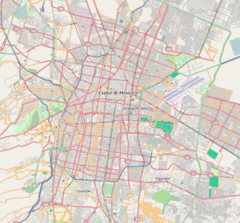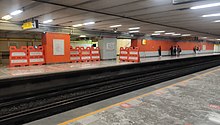railroad.wikisort.org - Station
Valle Gómez (![]() Mexican Spanish pronunciation (help·info)) is a Mexico City Metro station within the limits of Gustavo A. Madero and Venustiano Carranza, in Mexico City. It is an underground station with two side platforms, served by Line 5 (the Yellow Line), between Misterios and Consulado stations. Valle Gómez station serves the colonias of 7 de Noviembre and Valle Gómez; the station receives its name from the latter. The station's pictogram features an agave plant. Valle Gómez was opened on 1 July 1982, on the first day of the La Raza–Pantitlán service. In 2019, the station had an average daily ridership of 4,416 passengers, making it the 190th busiest station in the network and the least busy of the line.
Mexican Spanish pronunciation (help·info)) is a Mexico City Metro station within the limits of Gustavo A. Madero and Venustiano Carranza, in Mexico City. It is an underground station with two side platforms, served by Line 5 (the Yellow Line), between Misterios and Consulado stations. Valle Gómez station serves the colonias of 7 de Noviembre and Valle Gómez; the station receives its name from the latter. The station's pictogram features an agave plant. Valle Gómez was opened on 1 July 1982, on the first day of the La Raza–Pantitlán service. In 2019, the station had an average daily ridership of 4,416 passengers, making it the 190th busiest station in the network and the least busy of the line.
| STC rapid transit | ||||||||||||||||||||||||||||||||||||||||||||||||||||||||||||||||||||||||||||||||||||||||||||||||||||||||||
 Station sign, 2012 | ||||||||||||||||||||||||||||||||||||||||||||||||||||||||||||||||||||||||||||||||||||||||||||||||||||||||||
| General information | ||||||||||||||||||||||||||||||||||||||||||||||||||||||||||||||||||||||||||||||||||||||||||||||||||||||||||
| Location | Río Consulado Avenue Gustavo A. Madero and Venustiano Carranza, Mexico City Mexico | |||||||||||||||||||||||||||||||||||||||||||||||||||||||||||||||||||||||||||||||||||||||||||||||||||||||||
| Coordinates | 19°27′31″N 99°07′09″W | |||||||||||||||||||||||||||||||||||||||||||||||||||||||||||||||||||||||||||||||||||||||||||||||||||||||||
| Operated by | Sistema de Transporte Colectivo (STC) | |||||||||||||||||||||||||||||||||||||||||||||||||||||||||||||||||||||||||||||||||||||||||||||||||||||||||
| Line(s) | ||||||||||||||||||||||||||||||||||||||||||||||||||||||||||||||||||||||||||||||||||||||||||||||||||||||||||
| Platforms | 2 side platforms | |||||||||||||||||||||||||||||||||||||||||||||||||||||||||||||||||||||||||||||||||||||||||||||||||||||||||
| Tracks | 2 | |||||||||||||||||||||||||||||||||||||||||||||||||||||||||||||||||||||||||||||||||||||||||||||||||||||||||
| Connections |
| |||||||||||||||||||||||||||||||||||||||||||||||||||||||||||||||||||||||||||||||||||||||||||||||||||||||||
| Construction | ||||||||||||||||||||||||||||||||||||||||||||||||||||||||||||||||||||||||||||||||||||||||||||||||||||||||||
| Structure type | Underground | |||||||||||||||||||||||||||||||||||||||||||||||||||||||||||||||||||||||||||||||||||||||||||||||||||||||||
| Other information | ||||||||||||||||||||||||||||||||||||||||||||||||||||||||||||||||||||||||||||||||||||||||||||||||||||||||||
| Status | In service | |||||||||||||||||||||||||||||||||||||||||||||||||||||||||||||||||||||||||||||||||||||||||||||||||||||||||
| History | ||||||||||||||||||||||||||||||||||||||||||||||||||||||||||||||||||||||||||||||||||||||||||||||||||||||||||
| Opened | 1 July 1982 | |||||||||||||||||||||||||||||||||||||||||||||||||||||||||||||||||||||||||||||||||||||||||||||||||||||||||
| Key dates | ||||||||||||||||||||||||||||||||||||||||||||||||||||||||||||||||||||||||||||||||||||||||||||||||||||||||||
| 23 April 2020 | Temporarily closed | |||||||||||||||||||||||||||||||||||||||||||||||||||||||||||||||||||||||||||||||||||||||||||||||||||||||||
| 15 June 2020 | Reopened | |||||||||||||||||||||||||||||||||||||||||||||||||||||||||||||||||||||||||||||||||||||||||||||||||||||||||
| Passengers | ||||||||||||||||||||||||||||||||||||||||||||||||||||||||||||||||||||||||||||||||||||||||||||||||||||||||||
| 2021 | 912,959[1] | |||||||||||||||||||||||||||||||||||||||||||||||||||||||||||||||||||||||||||||||||||||||||||||||||||||||||
| Rank | 180/195[1] | |||||||||||||||||||||||||||||||||||||||||||||||||||||||||||||||||||||||||||||||||||||||||||||||||||||||||
| Services | ||||||||||||||||||||||||||||||||||||||||||||||||||||||||||||||||||||||||||||||||||||||||||||||||||||||||||
| ||||||||||||||||||||||||||||||||||||||||||||||||||||||||||||||||||||||||||||||||||||||||||||||||||||||||||
| ||||||||||||||||||||||||||||||||||||||||||||||||||||||||||||||||||||||||||||||||||||||||||||||||||||||||||
| Location | ||||||||||||||||||||||||||||||||||||||||||||||||||||||||||||||||||||||||||||||||||||||||||||||||||||||||||
 Location within Mexico City | ||||||||||||||||||||||||||||||||||||||||||||||||||||||||||||||||||||||||||||||||||||||||||||||||||||||||||
 | ||||||||||||||||||||||||||||||||||||||||||||||||||||||||||||||||||||||||||||||||||||||||||||||||||||||||||
| Area map | ||||||||||||||||||||||||||||||||||||||||||||||||||||||||||||||||||||||||||||||||||||||||||||||||||||||||||
Location

Valle Gómez is a metro station along Río Consulado Avenue, in northeastern Mexico City.[2] The station serves the colonias (Mexican Spanish for "neighborhoods") of 7 de Noviembre, in Gustavo A. Madero,[3] and Valle Gómez, in Venustiano Carranza.[4] Within the system, the station lies between Misterios and Consulado stations.[2] The area is serviced by Routes 5-A and 20-A of the city's public bus system[5] and by Route 200 of the Red de Transporte de Pasajeros network.[6]
Exits
There are two exits:[2]
- North: Río Consulado Norte Avenue and Norte 50 Street, 7 de Noviembre, Gustavo A. Madero.
- South: Río Consulado Sur Avenue and Real del Monte Avenue, Valle Gómez, Venustiano Carranza.
History and construction

Line 5 of the Mexico City Metro was built by Cometro, a subsidiary of Empresas ICA;[7] in the Valle Gómez–Misterios stretch, workers uncovered part of a road that connected Tenochtitlan with the Tepeyac hill.[8] The road was built with materials dating from the Mesoamerican Postclassic Period.[8]
Valle Gómez is an underground station that was opened on 1 July 1982,[9] on the first day of the La Raza–Pantitlán service.[10] The interstation stretch between Valle Gómez and Consulado goes from underground to the surface and it is 679 m (2,227 ft) long; the Misterios–Valle Gómez tunnel is 969 m (3,179 ft) long.[11]
The station's pictogram represents an agave plant,[12] and the station is named after the Valle Gómez family, owners of the former La Vaquita paddock, where agave plants would grow.[2] There is an Internet café inside the station.[2]
Incidents
According to the system authorities, the Consulado–Valle Gómez section is a common zone of copper wire thefts, which potentially can create fires in the tracks.[13] From 23 April to 15 June 2020, the station was temporarily closed due to the COVID-19 pandemic in Mexico.[14][15] In the Misterios–Valle Gómez tunnel, a train window was ejected and caused a short circuit on 21 February 2021.[16]
Ridership
According to the data provided by the authorities, between 2011 and 2021, commuters averaged between 2,300 and 4,900 daily entrances. In 2019, before the impact of the COVID-19 pandemic on public transport, the station's ridership totaled 1,611,907 passengers,[17] which was a decrease of 50,385 passengers compared to 2018.[18] In the same year, Valle Gómez was the 189th busiest station in the system and it was the line's least used station.[17]
| Annual passenger ridership | |||||
|---|---|---|---|---|---|
| Year | Ridership | Average daily | Rank | % change | Ref. |
| 2021 | 912,959 | 2,501 | 180/195 | +5.65% | [1] |
| 2020 | 864,127 | 2,361 | 190/195 | −46.39% | [19] |
| 2019 | 1,611,907 | 4,416 | 189/195 | −3.03% | [17] |
| 2018 | 1,662,292 | 4,554 | 189/195 | +2.58% | [18] |
| 2017 | 1,620,478 | 4,439 | 189/195 | −2.26% | [20] |
| 2016 | 1,657,884 | 4,529 | 188/195 | +1.33% | [21] |
| 2015 | 1,636,122 | 4,482 | 180/195 | +1.76% | [22] |
| 2014 | 1,607,802 | 4,404 | 181/195 | −0.82% | [23] |
| 2013 | 1,621,149 | 4,441 | 190/195 | −3.58% | [24] |
| 2012 | 1,681,310 | 4,593 | 174/195 | −4.82% | [25] |
| 2011 | 1,766,417 | 4,839 | 171/175 | – | [26] |
References
- "Afluencia de estación por línea 2021" [Station traffic per line 2021] (in Spanish). Sistema Transporte Colectivo Metro. 2022. Archived from the original on 7 March 2022. Retrieved 7 March 2022.
- "Valle Gómez" (in Spanish). Sistema de Transporte Colectivo Metro. Archived from the original on 5 July 2020. Retrieved 8 July 2020.
- "Colonia 7 de Noviembre, Código Postal 07840, Gustavo A. Madero, Distrito Federal" [7 de Noviembre, postal code 07840, Gustavo A. Madero, Mexico City] (in Spanish). Heraldo. Archived from the original on 2 May 2019. Retrieved 9 July 2020.
- "Colonia Valle Gómez, Código Postal 15210, Venustiano Carranza, Distrito Federal" [Valle Gómez, postal code 15210, Venustiano Carranza, Mexico City] (in Spanish). Heraldo. Archived from the original on 13 September 2019. Retrieved 9 July 2020.
- "Red de corredores" [Route network] (in Spanish). Retrieved 30 October 2021.
- "Red de Rutas" [Routes network] (in Spanish). Red de Transporte de Pasajeros. Retrieved 30 October 2021.
- "Línea 5, Ciudad de México" [Line 5, Mexico City] (in Spanish). iNGENET Infraestructura. 20 July 2009. Archived from the original on 2 September 2014. Retrieved 15 April 2020.
- Sánchez Vázquez, Ma. de Jesús; Mena Cruz, Alberto; Carballal Staedtler, Margarita (2010). "Investigación Arqueológica en la Construcción del Metro" [Archaeological Research in the Construction of the Metro] (PDF) (in Spanish). Mexico City: Instituto Nacional de Antropología e Historia. Archived (PDF) from the original on 9 July 2020. Retrieved 9 July 2020.
- "Valle Gómez Metro Station (Mexico City, 1982)". Structurae.net. Archived from the original on 9 July 2020. Retrieved 8 July 2020.
- Transporte: Seis años de esfuerzo conjunto [Transport: Six years of joint effort] (in Spanish). Vol. I. Government of the Federal District Department. 1987. p. 17.
- Gamez Rojas, Marlen (2010). "Análisis de riesgos de incendio en el Sistema de Transporte Colectivo Metro" [Analysis of fire risks in the Sistema de Transporte Colectivo Metro] (PDF) (in Spanish). Escuela Superior de Ingeniería Mecánica y Eléctrica. Instituto Politécnico Nacional. p. 95. Archived from the original (PDF) on 23 November 2020.
- López Munguía, Agustín (2006). "El metro, los alimentos y la biotecnología" [Metro: food and biotechnology] (PDF) (in Spanish). Dirección General de Divulgación de la Ciencia. National Autonomous University of Mexico. Archived (PDF) from the original on 20 January 2012. Retrieved 9 July 2020.
- Wachauf, Daniela (13 July 2021). "Ya les gustó robar cable en la Línea 5 del Metro" [Thefts have liked stealing cable on Metro Line 5]. 24 Horas (in Spanish). Archived from the original on 13 July 2021. Retrieved 2 August 2021.
- "Cierre temporal de estaciones" [Temporal closure of stations] (PDF) (in Spanish). Sistema Transporte Colectivo Metro. Archived (PDF) from the original on 4 July 2020. Retrieved 25 April 2020.
- Hernández, Eduardo (13 June 2020). "Coronavirus. Este es el plan para reabrir estaciones del Metro, Metrobús y Tren ligero" [Coronavirus. This is the plan to reopen Metro, Metrobús and Light Rail stations]. El Universal (in Spanish). Archived from the original on 4 July 2020. Retrieved 15 June 2020.
- López, Jonás (21 February 2021). "Ventana 'sale disparada' de tren de Línea 5 del Metro" [Window 'blown out' of Metro Line 5 train]. Excélsior (in Spanish). Archived from the original on 25 February 2021. Retrieved 4 May 2021.
- "Afluencia de estación por línea 2019" [Station traffic per line 2019] (in Spanish). Sistema Transporte Colectivo Metro. 2020. Archived from the original on 3 July 2020. Retrieved 3 May 2020.
- "Afluencia de estación por línea 2018" [Station traffic per line 2018] (in Spanish). Sistema Transporte Colectivo Metro. 2019. Archived from the original on 6 June 2019. Retrieved 7 April 2020.
- "Afluencia de estación por línea 2020" [Station traffic per line 2020] (in Spanish). Sistema Transporte Colectivo Metro. 2021. Archived from the original on 21 June 2021. Retrieved 21 June 2021.
- "Afluencia de estación por línea 2017" [Station traffic per line 2017] (in Spanish). Sistema Transporte Colectivo Metro. 2019. Archived from the original on 3 May 2020. Retrieved 3 May 2020.
- "Afluencia de estación por línea 2016" [Station traffic per line 2016] (in Spanish). Sistema Transporte Colectivo Metro. 2017. Archived from the original on 3 May 2020. Retrieved 3 May 2020.
- "Afluencia de estación por línea 2015" [Station traffic per line 2015] (in Spanish). Sistema Transporte Colectivo Metro. 2016. Archived from the original on 3 May 2020. Retrieved 6 May 2020.
- "Afluencia de estación por línea 2014" [Station traffic per line 2014] (in Spanish). Sistema Transporte Colectivo Metro. 2015. Archived from the original on 3 May 2020. Retrieved 6 May 2020.
- "Afluencia de estación por línea 2013" [Station traffic per line 2013] (in Spanish). Sistema Transporte Colectivo Metro. 2014. Archived from the original on 3 May 2020. Retrieved 6 May 2020.
- "Afluencia de estación por línea 2012" [Station traffic per line 2012] (in Spanish). Sistema Transporte Colectivo Metro. 2013. Archived from the original on 3 May 2020. Retrieved 6 May 2020.
- "Afluencia de estación por línea 2011" [Station traffic per line 2011] (in Spanish). Sistema Transporte Colectivo Metro. 2012. Archived from the original on 6 May 2020. Retrieved 6 May 2020.
External links
 Media related to Valle Gómez (station) at Wikimedia Commons
Media related to Valle Gómez (station) at Wikimedia Commons- "Metro Valle Gómez". At the Official Guide to Mexico City.
Другой контент может иметь иную лицензию. Перед использованием материалов сайта WikiSort.org внимательно изучите правила лицензирования конкретных элементов наполнения сайта.
WikiSort.org - проект по пересортировке и дополнению контента Википедии